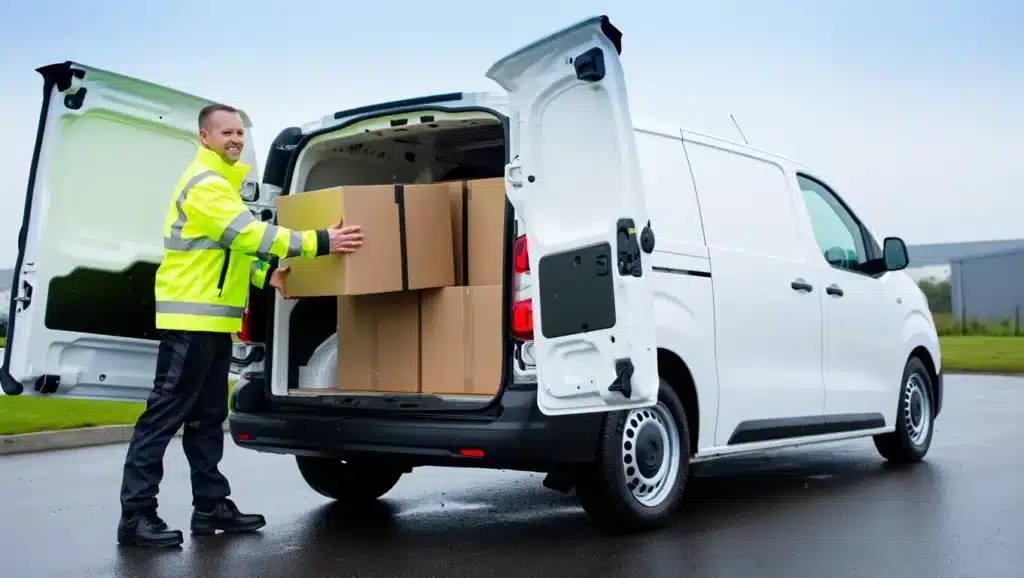Loading a van safely in wet or slippery conditions takes more than just common sense, it’s about planning ahead and working smart. Rain, mud, or ice can quickly turn a routine job into a risky one. In this guide, we’ll walk you through how to load a van safely in wet or slippery conditions, with proven tips and real-world examples to help you stay safe and protect your cargo.
If you’re new to van hire or loading, you might also want to read our guide on how to load a van efficientlyfor extra advice on space management and stacking.
Why Wet Conditions Make Van Loading Riskier
When the ground or van floor is wet, you lose the friction that helps you stay stable. That’s why so many injuries happen during rainy or icy days, the UK Health and Safety Executive (HSE) reports that slips and trips make up over 30% of workplace injuriesevery year.
A single slip while lifting a heavy item could mean not only personal injury but also damaged goods or van interiors.
For example:
A local courier based in Maidstone told us how a single wet morning cost him a day’s work after slipping on his tail lift while loading boxes. Now, he always carries a small towel to dry surfaces before use, a simple habit that saves time and injury.
If you’re not sure what size or type of van suits your job, check out our breakdown of what a Luton van is and why it’s ideal for bad weather moves.
Preparation Before Loading Your Van
A few minutes of preparation can prevent serious accidents and delays.
- Inspect your area:Look for puddles, mud, or uneven surfaces.
- Wear proper footwear:Non-slip safety boots with deep tread patterns can reduce slipping by up to 50%, according to the Royal Society for the Prevention of Accidents (RoSPA).
- Plan your load:Place heavier items at the front near the bulkhead to balance weight. If you’re unsure how much your van can safely carry, our article on understanding payload limits for vansexplains it clearly.
- Protect your goods:Use waterproof covers or tarpaulins to prevent water damage.
- Keep drying tools handy:Towels or wipes to dry ramps and door handles go a long way.
Real example:One Hire2You customer from Chatham hired a Luton vanfor a house move during a downpour. By pre-loading lighter boxes first and covering heavier furniture in waterproof sheeting, they avoided both water damage and the risk of slipping on the ramp.
For more general moving advice, our guide on seasonal van hire in Kentcovers how to plan around unpredictable British weather.
Step-by-Step Guide to Safe Loading in Wet Weather
Follow these simple steps to stay safe and efficient when loading a van in bad weather:
- Park smart:Choose level, hard ground. Avoid slopes, grass, or mud.
- Clear your path:Brush away debris or leaves.
- Wipe down surfaces:Dry ramps, handles, and steps before you begin.
- Lift correctly:Bend your knees and keep the load close to your body.
- Load in order:Start with heavy items first, then medium, then light.
- Secure as you go:Don’t wait until everything’s inside, strap down each section to stop shifting.
If you’re loading alone, pace yourself. Slowing down for a few extra minutes beats losing your grip in the rain. You can find more common mistakes to avoid in our article on van hire errors people often make.
How to Secure Your Load and Protect Your Van Interior
Keeping your load secure is critical, especially when driving through wet, winding roads.
- Use ratchet straps, cargo bars, or netsto lock items in place.
- Keep lighter items on topto avoid crushing boxes.
- Use rubber matsor anti-slip liners to stop movement on wet floors.
- Don’t push damp items directly against the van’s side panels.
- Wipe down any moisture before closing doors, damp air can damage wooden furniture or soft furnishings during long drives.
If you’re using a hire van with a tail lift, you’ll find it far easier to work safely in the rain — learn more about your options in our van hire page.
For more information on vehicle choice and insurance, you might find these useful:
Driving a Loaded Van Safely After Rain
Once everything is secured, take your time on the road. A fully loaded van behaves differently in the rain, stopping distances can double, and turns need more control.
- Accelerate smoothlyto avoid wheel spin.
- Brake early and gently, don’t slam the brakes.
- Increase your following distancefrom the car ahead.
- Avoid standing water where possible.
- Check tyres and wipersbefore setting off, they’re your first line of defence against rain.
Even experienced drivers get caught out by slippery roads, so it’s worth taking a few extra minutes to drive carefully. You can explore more driving and hire advice on our Hire2You blog.
Wet Weather Van Loading Safety Checklist
| Step | Task | Done |
|---|---|---|
| 1 | Inspect the loading area for puddles or slopes | ☐ |
| 2 | Put on non-slip footwear and gloves | ☐ |
| 3 | Plan load order – heavy to light | ☐ |
| 4 | Dry ramps, steps, and floor before loading | ☐ |
| 5 | Secure items with straps immediately | ☐ |
| 6 | Double-check waterproof covers | ☐ |
| 7 | Test doors and latches before driving | ☐ |
This checklist is ideal to keep in your phone notes or printed in the cab. It takes less than five minutes to run through and can save you from costly mistakes.
For cost comparisons between hiring or using movers, read our post on van hire vs removal companies.
FAQs
Q1: How do you stop slipping when loading a van?
Wear non-slip footwear, keep ramps dry, and take smaller steps when carrying heavy items.
Q2: What’s the safest way to lift heavy items in the rain?
Use two people when possible, bend your knees, and avoid twisting your back. Use lifting aids or tail lifts if available.
Q3: How do you protect items from getting wet?
Waterproof covers, shrink wrap, or tarps are the easiest options. Always cover the floor of the van with a mat or liner.
Q4: What footwear should you wear when loading a van?
Non-slip, waterproof safety boots with good ankle support, they’ll help you maintain grip on wet metal or concrete.
Q5: Is it safe to drive a van right after loading in wet weather?
Yes, if the load is secure and the interior is dry. Take it slow and increase braking distance.
Conclusion
Loading a van in wet or slippery conditions doesn’t have to be stressful, preparation and awareness go a long way. From checking the ground to strapping down loads securely, small steps make a big difference in keeping both you and your cargo safe.
At Hire2You, we make it easy to hire a reliable van, rain or shine.
No deposit, no credit check, no hassle.
Drive away today from just £49/dayand move with confidence whatever the weather.
👉 Book your van hire today at Hire2You.co.uk
Person safely loading a white Luton van in rainy UK conditions, wearing hi-vis jacket and safety boots on a wet driveway.

